This post is one in a series following six brewers collaborating to each make a small adjustment to a single recipe in order to improve it, then pass it along to the next brewer. We hope to learn more about the art of recipe creation as we see how other brewers approach the same recipe. The rest of the series can be found here.
Author: R. Goyenko
Brew Day
This brewday was a bit different since the deadline to brew was on April 1, and I had a vacation a week before that. We tried to arrange for the beer to get there before the vacation so I could brew before I left. It almost happened through the collective effort, but the previous beer wasn’t there before I left, so I ended up brewing after my deadline, but everything else went smoothly with this brew.
I do BIAB, so the setup is simple—a brewing bag, a big pot, some blankets, a burner, and a fermenter. At this point the procedure is established. I put the recipe in Beersmith with my changes to the recipe and adjustments for the water chemistry.
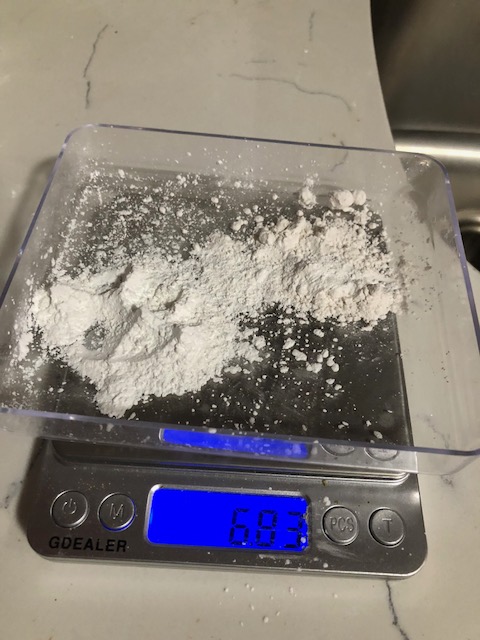
I measured out the grains and milled them.
Then the water – I used about 8.3 gallons for this batch. The previous recipe was a bit sweet and finished at a final gravity of 1.020, so I decided to lower the temperature slightly to the temperature used in previous recipes: 154⁰F, which I came pretty close to.

I mashed in, and after about 10 minutes, I measured the Ph of water. It was pretty close to what Bru’n’Water predicted—a bit on a high side, but ok.
After one hour of mashing, I got the bag out and drained the wort. The pre-boil gravity came in at 1.050.
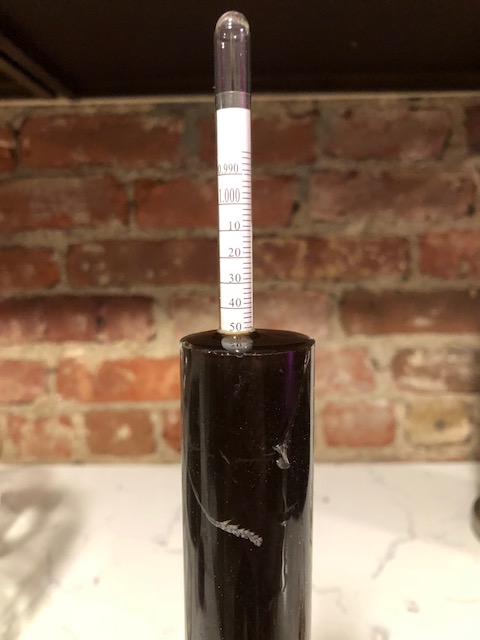
Here comes a bit of a diversion: I’ve started doing one gallon, experimental batches from the grain left from the main mash. I don’t squeeze the bag, and I wash it with hot water to gather 1.5-2 gallons of wort. I change something with that wort so I can compare it to the main boil. In this case I infused the secondary wort with 4 oz. of Special B malt.
In the meantime the main beer was boiling.
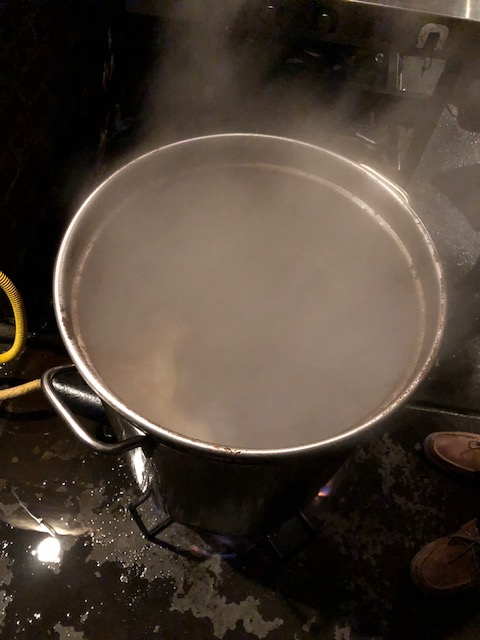
I measured and added the hops at the times in the recipe. After the boil, I chilled the wort quickly (it was still very cold outside, so it chilled in about 10 minutes). I measured the OG, and it came in as expected at 1.064
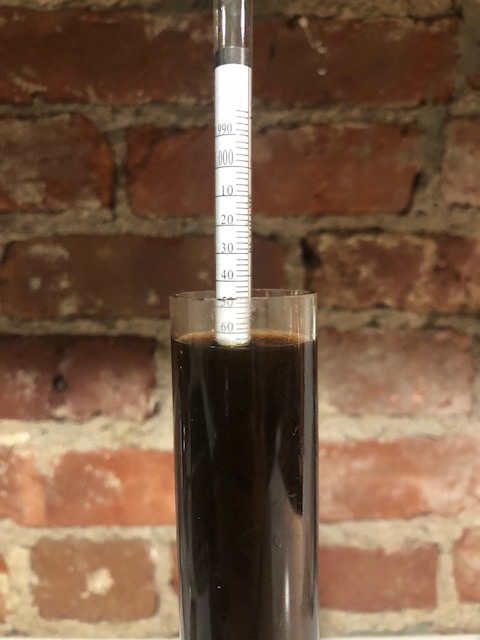
I transferred the wort to the carboy (I have a cool old glass one which I won in a lottery in beer swap raffle) and pitched the yeast.
I forgot that I needed yeast for my experiment brew, but luckily I had some San Diego Super yeast (WLP090) in the fridge. That’s what I like about the experimental batches – since it’s an experiment I can change two things or even screw it up, and it’s not a big deal.
The OG on the experimental batch was 1.060 (a bit lower since it was sort of a non-traditional parti-gyle, but not too low because I infused with Special B it and boiled off a bunch of water).
I finished pretty late at night and checked on the beer in the morning; it was still dormant after about 7 hours. After I came back from work, though, it was bubbling happily (I love bubbling beer—it’s such a joy looking at this living thing).
After 6 days, signs of fermentation stopped and the krausen dropped. The gravity was at 1.020. I measured 3 days after that and the gravity was the same.
I decided to bottle this beer even though I usually keg—I figured I would need to bottle a bunch anyway, so it would just save me some hustle.
I measured dextrose to make it to 2.1 volumes of CO2, transferred to the bottling bucket, and mixed gently. Washing the bottles beforehand is always the worst part for me.
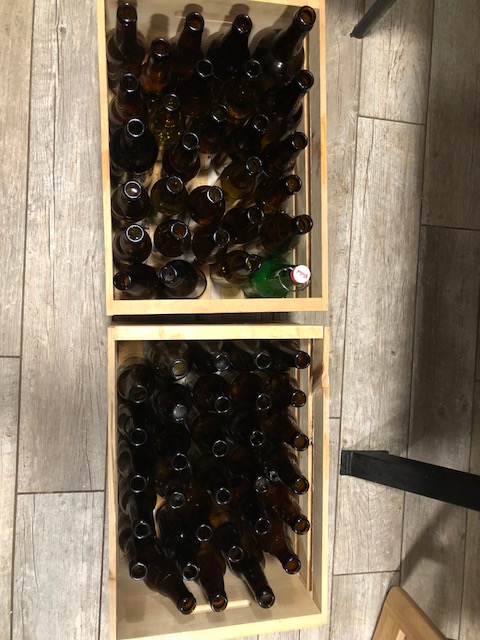
The experimental batch finished lower at 1.015 from the lower OG of 1.060, and I bottled it as well.
Recipe
Tasting notes from Iteration 4:
Aroma: Strong dark fruit aroma from malt – raisins, figs, dried plums. Strong and pleasant dark malt aroma with chocolate, toffee, and some coffee flavor. No hop aroma or it’s hiding behind the stronger malt.
Appearance: Dark brown, looks reddish if you put it to the light, moderate head of cream/tan color that lasts for some time, some lacing on the glass walls. Foam stays for a while.
Flavor: Full bodied, with medium-low bitterness from hops. The flavor is similar to aroma – malty, dark fruits, a bit of bitterness from hops, but the balance is towards the malt. Finish is medium-sweet.
Mouthfeel: Carbonation is medium, full body.
I also had a friend from my homebrew club provide his thoughts, which were as follows:
“Great body and carbonation. Tan, dark brown. Dark chocolate and crust aroma, good level of roasted barley flavor with a dry malt profile probably from the roasted barley. Little bit of chocolate. Does finish sweet with citrus bitterness.”
After tasting this beer I thought through what I would change. It’s very good beer; I like the aroma a lot, and the flavor is good too. The one thing I think could improve is that it tastes and looks more like brown ale than a stout. I think it needed a more robust roasted flavor–roasted barley I think would help with both the appearance and roastiness of the beer. So, that’s what I decided to bring back up. I know that’s what previous brewer brought down from, but I reasoned that since Iteration 3 was much lower in gravity—if the gravity on mine were higher, it could sustain more roast.
- Mashed at 154° for 60 minutes
- 69.2% 2-row
- 10.8% Victory
- 7.7% Flaked Barley
- 7.7% Roasted Barley
- 4.4% Chocolate (300°L)
- Boiled for 60 minutes
- 0.89oz Nugget (60 min.) at 14.0% AA (41.5 IBUs)
- 1 oz Willamette (5 min.) at 4.8% AA (3 IBUs)
- Pitched Safale US-05
- OG: 1.064
- FG: 1.020
- ABV: 5.8%
Tasting
Iteration 5 tasting notes:
Aroma: Dried plums, raisins, dried stone fruits, ash aroma, dark roasted coffee, chocolate, highly roasted breadcrumb.
Appearance: Dark brown, almost black, big dark tan head that persists, nice lacing. Bubbles are small and look velvety.
Flavor: Dark roasted malt, burnt coffee grounds, malt sweetness is on lower side, hops are subdued, finish is medium-dry.
Mouthfeel: Medium body, creamy, a bit of astringency, medium carbonation.
My friend provided the following tasting notes:
“Raisins/plums or dark fruit aroma. Slightly less carbonation and mouthfeel—a little thinner. Much darker color. A little bite from roasted barley, but good balance of malty sweetness, esters, and roasty flavor.”
I also took this beer to my BJCP training class and had it evaluated by 12 people, some who are training and some who are certified BJCP judges. Their scoresheets can be found here: BJCP Scoresheets for Iteration 5
Overall I think the beer came out pretty well. The appearance improved and there is more roastiness, but I think it might be too much. If I were to brew this again, I might dial the roasted barley down from 7.7% to around 6% so there is less harshness and in hopes that the maltiness and related flavors/aromas would come through better.
Another thing I think would benefit this beer is more hops so they come through more assertively.
Thoughts on the one-gallon experimental beer:
Carbonation is higher, higher in body, has more intense dark fruit/figs from malt, less fruity flavors/cleaner flavor. Finishes drier, has some more harshness I think from Special B.
My friend’s thoughts: “Lots of carbonation, great body. Less estery. Black in color. Cleaner beer, drier, and little harsher in roasted flavor.”
I think this shows the difference in yeast, as it has much cleaner/drier flavor and not too many esters. Special B added some interesting notes, but it’s a bit much; I think that maybe substituting some of the roasted barley for special B would work.
The difference in yeast is also pretty interesting. I think it shows how simply changing the yeast can dramatically alter the aroma/flavor.
Recipe Progression
| Iteration 1 | Iteration 2 | Iteration 3 | Iteration 4 | Iteration 5 | |
| Base Malt 2-row | 80% | 80% | 80% | 72.5% | 69.2% |
| Specialty Malt 1 | 10% Victory | 10% Victory | 5% Victory | 10.8% | 10.8% |
| Specialty Malt 2 | 5% Roasted Barley | 5% Roasted Barley | 10% Roasted Barley | 4.4% Roasted Barley | 7.7% Roasted Barley |
| Specialty Malt 3 | 5% Carafa III | 5% Chocolate Malt | 5 % Chocolate Malt | 4.4% Chocolate Malt | 4.4% Chocolate Malt |
| Specialty Malt 4 | None | None | None | 7.8% Flaked Barley | 7.7% Flaked Barley |
| 60 min. hop | Nugget: 47.7 IBUs | Nugget: 42.5 IBUs | Nugget: 47.7 IBUs | Nugget: 41.2 IBUs | Nugget: 41.5 IBUs |
| 5 min. hop | Willamette: 3.6 IBUs | Willamette: 3.3 IBUs | Willamette: 2.9 IBUs | Willamette: 3 IBUs | Willamette: 3 IBUs |
| Yeast | US-05 | US-05 | US-05 | US-05 | US-05 |
| OG | 1.054 | 1.060 | 1.045 | 1.065 | 1.064 |
| FG | 1.010 | 1.016 | 1.005 | 10.20 | 1.020 |
| ABV | 5.8% | 5.8% | 5.25% | 5.9% | 5.8% |

Pingback: Stout: Tasting Iterations 4 & 5 | brewublog
Pingback: Stout: Iteration 6 | brewublog
Pingback: Stout: Tasting Iterations 5 & 6 | brewublog
Pingback: Stout: Iteration 11 | brewublog